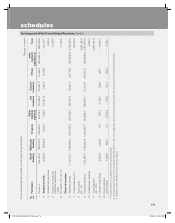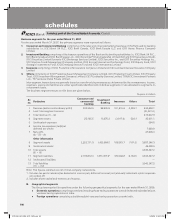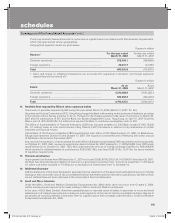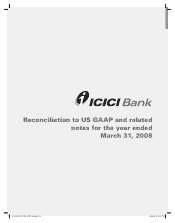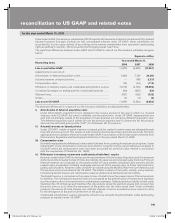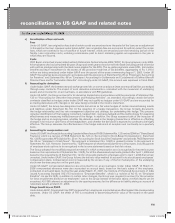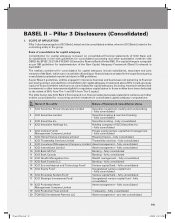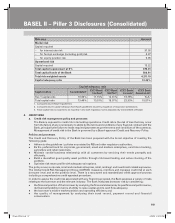ICICI Bank 2008 Annual Report Download - page 163
Download and view the complete annual report
Please find page 163 of the 2008 ICICI Bank annual report below. You can navigate through the pages in the report by either clicking on the pages listed below, or by using the keyword search tool below to find specific information within the annual report.
F89
Under Indian GAAP, the insurance subsidiaries (ICICI Prudential Life Insurance Company Limited and ICICI Lombard
General Insurance Company Limited) are fully consolidated whereas under US GAAP, these subsidiaries are
accounted for by the equity method of accounting as the minority shareholders have substantive participating
rights as defined in Issue No. 96-16 issued by the Emerging Issues Task Force.
The significant differences between Indian GAAP and US GAAP in case of our life insurance subsidiary are given
below:
Rupees in million
Reconciling items Year ended March 31,
2006 2007 2008
Loss as per Indian GAAP ...................................................................... (1,879) (6,489) (13,951)
Adjustments on account of:
Amortisation of deferred acquisition costs ........................................... 5,660 7,729 24,365
Actuarial reserves on lapsed policies .................................................... — 968 2,333
Compensation costs .............................................................................. (72) (44) (113)
Difference in statutory reserve and unallocated policyholders’ surplus (5,016) (4,792) (18,985)
Un-realised (loss)/gain on trading portfolio of participating funds ........ 808 (605) 833
Deferred taxes ........................................................................................ (597) (126) (532)
Others .................................................................................................... (3) (3) (3)
Loss as per US GAAP ........................................................................... (1,099) (3,362) (6,053)
The aforesaid differences in respect of our life insurance subsidiary are described below:
i) Amortisation of deferred acquisition costs
Under Indian GAAP, acquisition cost is charged to the revenue account in the year in which it is incurred
whereas under US GAAP, the same is deferred over the policy term. Under US GAAP, expenses that vary
with and are primarily related to the acquisition of new business are carried as deferred acquisition cost.
This deferred acquisition cost is written off over the premium payment term for Statement No. 60 products
and over the estimated gross profits (“EGP”) for Statement No. 97 products.
ii) Actuarial reserves on lapsed policies
Under US GAAP, certain actuarial reserves on lapsed policies created in earlier years are released through
the profit and loss account. The release of such actuarial reserves have been accounted as funds for future
appropriations as a balance sheet item under Indian GAAP in accordance with the instructions received from
the Insurance Regulatory and Development Authority for the year ended March 31, 2008.
iii) Compensation costs
It primarily represents the differences in the method followed for accounting of employee stock options. Under
Indian GAAP, stock compensation costs are accounted for using the intrinsic value method as compared to
US GAAP where the compensation costs have been accounted for at the fair value method in accordance
with the requirement of Statement No. 123(R).
iv) Differences in statutory reserve and unallocated policyholders’ surplus
Reserves under Indian GAAP are held as per the requirements of the Insurance Regulatory and Development
Authority and the Actuarial Society of India. Accordingly, the reserves are computed using the Gross Premium
Method (reserves are computed as the present value of future benefits including future bonuses and the
present value of expenses including overheads and are net of the present value of future total premiums,
paid by policyholders). Reserves under US GAAP are valued using the Modified Net Premium Method as per
the valuation norms prescribed under US GAAP. The liability consists of two parts, namely, policy reserves
(comprising benefit reserve and maintenance expense reserve) and deferred premium liability.
The benefit reserve is computed as the present value of benefits less the present value of the net premium
for benefits. The maintenance expense reserve is computed as the present value of maintenance expenses
less the present value of net premiums for maintenance expenses. Deferred premium liability is held under
Statement No. 97 limited pay and Statement No. 60 products where the premium paying term is lower than
the policy term so as to allow the emergence of the profits over the entire policy term. Under unit-linked
products, the excess of initial charges over ultimate charges is held as unearned revenue reserve to allow
for the emergence of the profit over the term of the policy.
Unallocated policyholders’ surplus represents amount to be set aside for policyholders’ under participating
products as required under US GAAP.
reconciliation to US GAAP and related notes
for the year ended March 31, 2008
ICICI_BK_AR_2008_(F47_F92).indd 89ICICI_BK_AR_2008_(F47_F92).indd 89 6/20/08 3:33:32 PM6/20/08 3:33:32 PM


